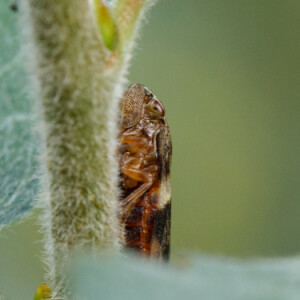Hopping
When I took myself off to Trench Wood this morning I was hoping for two things: firstly, to avoid the thunderstorms that were threatened by the weather forecast, and secondly, to photograph some invertebrates I hadn't yet captured on camera this season. I did pretty well on both counts, failing to get hit by lightning - and in fact, only getting very slightly wet on the last few yards of my dash back to the car - but also achieving reasonable images of some quite nice species. When I have more time I'll round up my favourites into a Facebook post, but for tonight I've picked this hopper because - well, because hoppers, for one thing, but also because it's not just a first for the season, but a first ever record for me of this species.
The alder spittlebug (Aphrophora alni) belongs to a family called the Aphrophoridae, commonly known as froghoppers, and it's one of the largest representatives, at around a centimetre in length. By comparison the common froghopper (Philaenus spumarius) is 5-7mm long. Given its size I wasn't especially proud of myself for spotting it, at around shoulder height, on an aspen sapling in one of the 'nursery' areas along the main ride, but like most hoppers it was inclined to be reclusive, and led me a bit of a dance as I tried to capture its portrait, so I am quite pleased with the two images I've posted here. The extra would have been a pretty good ventral shot but for the intervening leaf, but I'm forgiving of its deficiencies because the bug was shuffling round and round the stem at the time. The main image was captured one-handed, as I bent the stem over with the other to place the froghopper in better light.
Despite its common name, the alder spittlebug doesn't confine itself to alder, but is polyphagous, feeding from a range of plants. The adults prefer deciduous trees and bushes, especially willows, birch, alder and poplars (including aspen), but the larvae prefer herbaceous plants, and adult females move down from their trees to oviposit among herbaceous leaves and stems. The eggs overwinter and hatch the following spring, and each larva then creates a foam environment on a suitable stem, inside which it develops to adulthood.


Comments
Sign in or get an account to comment.


